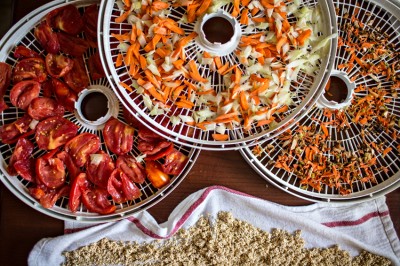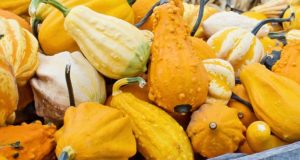Many foods in long-term food storage are dry goods. These are foods like pasta or rice that are dried and then cooked in water to varying degrees. However, there’s a broader category of dehydrated foods that includes vegetables and meat substitutes commonly referred to as TVP or “textured vegetable protein.”
While preparing foods like pasta and rice is fairly straightforward, properly rehydrating vegetables and TVP to ensure proper tenderness, flavor and nutrition is a bit more complex. Water is often used as the rehydrating ingredient, but other things are used as well: broths or stocks, fruit juice and milk.
In addition, the temperature of the rehydrating liquid along with the time, duration and incorporation into a recipe varies. This variation is sometimes due to the nature of the dehydrated food or the final recipe.
Dehydrated Food Variations
The table below serves as a rough cheat-sheet to understand the minimum soaking times for various dried and dehydrated foods. The default liquid for rehydrating is water, but it should always be cold or at least not in excess of room temperature. Rehydrating in hot liquids can discolor some dehydrated foods like onions, turning them a light pink, or leach out too many nutrients such as the beta-carotene in dehydrated carrots. However, you may encounter some recipes that require you to add a hot liquid. This is sometimes true with rehydrated potato slices. If in doubt, follow the recipe or the table below.
Be Forewarned
Rehydrating before cooking is often a good idea. Even if the recipe you have on hand says you can add the dehydrated food and assume that full rehydration will occur, that can also fail.
The World’s Healthiest Long-Term Storage Food. Read More Here
There’s nothing worse than expecting a nice sliced potato casserole to come out perfect, only to find that some of the potato slices have the consistency of shoe leather.
Rehydrating Is Not Just About Water
Something else to keep in mind is that you don’t always have to use water. You could use a fruit juice like apple juice to rehydrate most fruits, or a powdered drink mix of your choice. The rehydrated fruit will pick up some of the flavor notes of the juice and the dilution of the original fruit flavor will be lessened to some degree.
Another option is using a stock or broth to rehydrate TVP or vegetables that you will be using in a savory dish such as a soup or stew. You can make the stock from scratch or use bouillon, but once again, make sure the liquid is cold or at least at room temperature. Hot liquids seem to have an adverse effect on many dehydrated foods. Also, don’t overdo it with the bouillon. Dehydrated foods soak up liquids quickly and entirely. If the broth is too salty, it will make your vegetables too salty.
The Rehydrated Food Grid
This table is designed to give you general proportions of dehydrated food to liquid and minimum soaking times. In all instances you can exceed the minimums by double, and in the case of dried beans you can go as long as 24 hours.
| Product | Water to add to 1 cup dried food | Minimum soaking time (hours) |
| Fruits | ||
| Apples, sliced | 1 1/2 | 1/2 to 2 |
| Pears, sliced | 1 3/4 | 1 1/4 |
| Peaches, sliced | 2 | 1 1/4 |
| Vegetables | ||
| Asparagus | 2 ¼ | 1 ½ |
| Beans, lima | 2 ½ | 1 ½ to 24 hrs |
| Beans, green snap | 2 ½ | 1 |
| Beets | 2 ¾ | 1 ½ |
| Carrots | 2 1/4 | 1 to 2 |
| Cabbage | 3 | 1 |
| Corn | 2 ¼ | ½ to 2 |
| Okra | 3 | ½ |
| Onions | 2 | ¾ |
| Peas | 2 ½ | ½ to 1 |
| Pumpkin | 3 | 1 |
| Squash | 1 ¾ | 1 |
| Spinach | 1 | ½ |
| Potatoes | 1 ½ | ½ to 1 |
| Turnip Greens and other greens | 1 | ¾ |
| Grains | ||
| Rice – White, brown or wild | 2 | until steamed |
| Pasta | 1 quart | al dente |
| Dehydrated Meats | ||
| Poultry | 1 cup stock | 30 to 1 |
| Ground Beef Crumbles, Deli Meat | 1 cup stock | 30 |
| Textured Vegetable Protein | 1 stock based on TVP flavor | 30 |
To Drain or Not to Drain
If you are rehydrating outside of a recipe that calls for the simple addition of the food, you should drain the liquid, but do a test first. Take what you have rehydrated and test it for consistency, taste, texture and mouth feel. If it’s tough or leathery, or doesn’t taste right, give it some more time. Remember, too, that you’ll probably be adding flavorings or seasonings and other ingredients in a recipe, but take the time to assess texture before draining the liquid.
You might also want to reserve the liquid as a base for a recipe or stock but taste it first. Rehydrated onions create a great onion-flavored base, and many fruits do as well. Potatoes and beans? Not so much.
Remember the Concept
Think ahead to what you are cooking or trying to prepare. A “dump and stir” approach to dehydrated foods can give you unsatisfactory results. With time and experimentation, you’ll understand better how to manage rehydration. The key is to experiment today rather than at a stressful time when all you have to eat is long-term food stores. If you haven’t heard, “Eat what you store and store what you eat.” This is a good reason to start that practice, and in the process understand the nuances of rehydrating dehydrated foods.
What advice would you add? Share your thoughts in the section below:
 Off The Grid News Better Ideas For Off The Grid Living
Off The Grid News Better Ideas For Off The Grid Living




